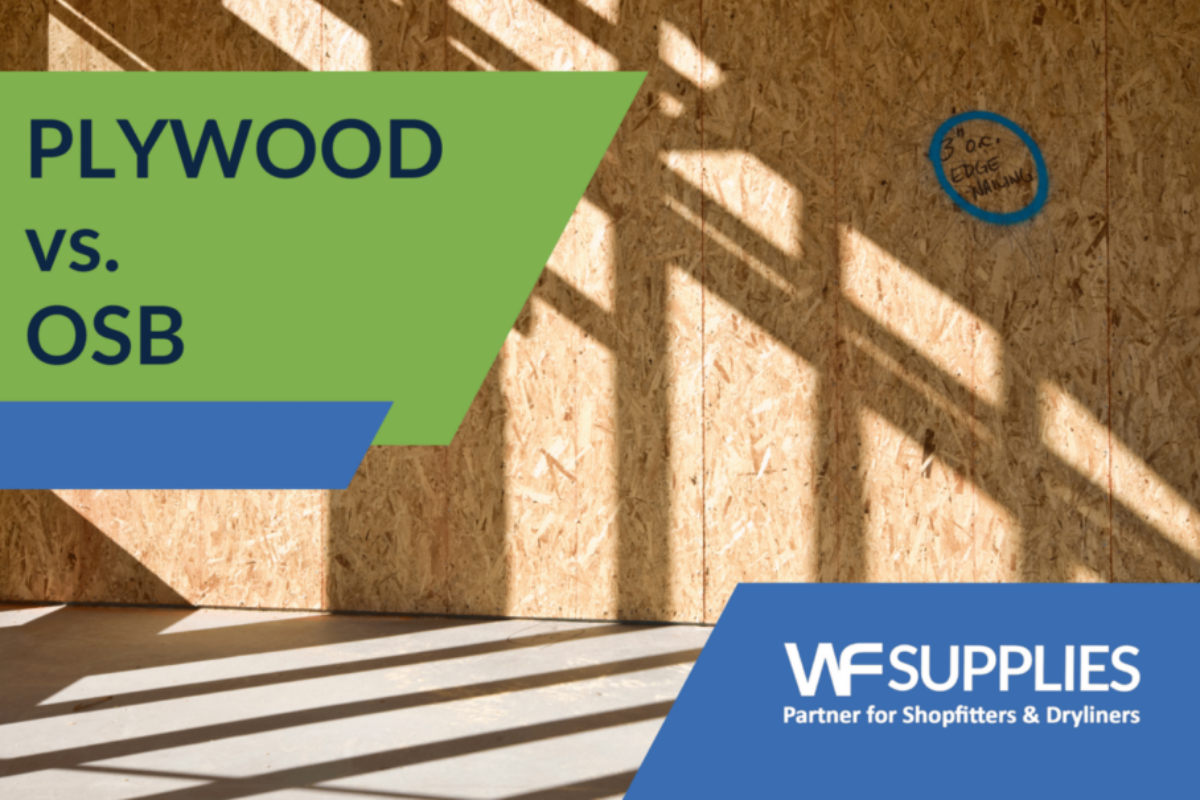OSB vs. Plywood: Choosing the Right Material for Your Project
Oriented Strand Board (OSB) and plywood stand out as two of the most popular wood-based panel choices for shopfitters and dryliners, each with its own set of advantages and considerations. Understanding the differences between OSB and plywood is crucial for making informed decisions in your project. Let’s delve into the characteristics of both materials to help you choose the right one for your needs.
Ply and OSB is commonly used by shopfitters and dryliners when construction internal metal partitions. This is used between the metal studs and plasterboard to increase the strength of the wall and allow for easy fixing of wall hanging objects to the completed partition.
What is OSB?
Oriented Strand Board, commonly known as OSB, is a type of engineered wood panel made from compressed strands of wood with adhesive resins. These strands are arranged in layers, oriented in alternating directions to enhance the panel’s strength and stability. OSB is typically made from fast-growing species of wood, making it a cost-effective option compared to plywood.
Advantages of OSB:
- Cost-Effectiveness: OSB is generally more affordable than plywood, making it a preferred choice for budget-conscious projects.
- Consistency: OSB panels offer consistent density and thickness throughout the sheet, reducing the risk of voids or weak spots.
- Moisture Resistance: While not entirely waterproof, OSB performs well in humid environments and can withstand occasional exposure to moisture better than traditional plywood.
- Eco-Friendly: OSB is often manufactured from sustainably sourced wood species, contributing to its eco-friendly appeal.
Considerations with OSB:
- Sensitivity to Moisture: While OSB is more moisture-resistant than plywood, prolonged exposure to water can cause swelling and delamination, compromising its structural integrity.
- Appearance: Some may find the appearance of OSB less visually appealing compared to plywood, as it has a distinctive textured surface composed of wood strands.
What is Plywood?
Plywood is another engineered wood product, consisting of thin layers of wood veneers glued together with alternating grain directions. This cross-grain construction gives plywood its strength and dimensional stability, making it suitable for a wide range of applications.
Advantages of Plywood:
- Strength and Stability: Plywood is renowned for its superior strength and dimensional stability, making it ideal for structural applications where load-bearing capacity is crucial.
- Wide Range of Grades: Plywood is available in various grades, offering options for different levels of quality and performance depending on the specific requirements of the project.
- Smooth Surface: Unlike OSB, plywood typically has a smooth and uniform surface, making it easier to paint, stain, or apply finishes for a polished appearance.
- Resistance to Warping: Plywood tends to resist warping and shrinkage better than OSB, making it a preferred choice for projects where stability is paramount.
Considerations with Plywood:
- Cost: Plywood is often more expensive than OSB, particularly for higher grades and specialty types.
- Environmental Impact: The production of plywood may involve more intensive manufacturing processes compared to OSB, leading to potentially higher environmental impact depending on the sourcing and production practices.
When deciding between OSB and plywood, it’s essential to consider the specific requirements and constraints of your project. For structural applications where strength and stability are critical, plywood may be the preferred choice. However, if cost-effectiveness is the primary concern, OSB could be a suitable alternative.
Ultimately, both OSB and plywood have their own unique strengths and weaknesses, and the optimal choice will depend on factors such as budget, project specifications, and environmental considerations. By weighing these factors carefully and understanding the characteristics of each material, you can make an informed decision that ensures the success and longevity of your project.
As partners to shopfitters and dryliners, WF Supplies stock large quantities of both ply and OSB in a range of size and grades. Contact us today to discuss your project requirements of check out our range online here.

